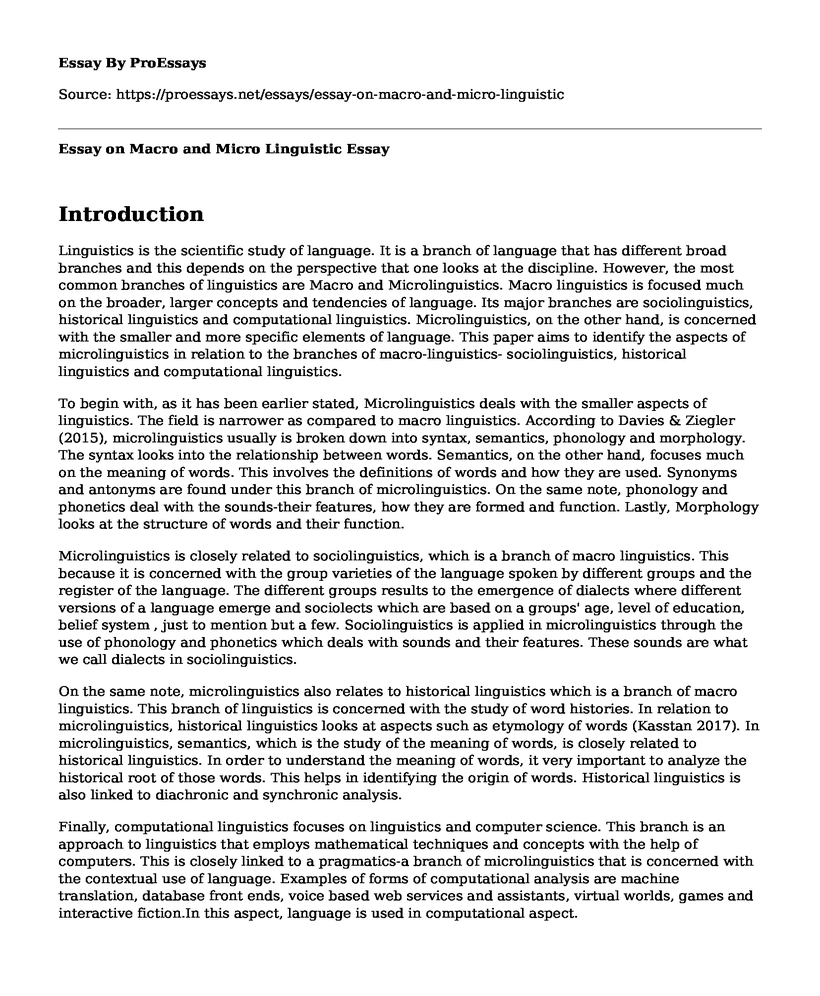Introduction
Linguistics is the scientific study of language. It is a branch of language that has different broad branches and this depends on the perspective that one looks at the discipline. However, the most common branches of linguistics are Macro and Microlinguistics. Macro linguistics is focused much on the broader, larger concepts and tendencies of language. Its major branches are sociolinguistics, historical linguistics and computational linguistics. Microlinguistics, on the other hand, is concerned with the smaller and more specific elements of language. This paper aims to identify the aspects of microlinguistics in relation to the branches of macro-linguistics- sociolinguistics, historical linguistics and computational linguistics.
To begin with, as it has been earlier stated, Microlinguistics deals with the smaller aspects of linguistics. The field is narrower as compared to macro linguistics. According to Davies & Ziegler (2015), microlinguistics usually is broken down into syntax, semantics, phonology and morphology. The syntax looks into the relationship between words. Semantics, on the other hand, focuses much on the meaning of words. This involves the definitions of words and how they are used. Synonyms and antonyms are found under this branch of microlinguistics. On the same note, phonology and phonetics deal with the sounds-their features, how they are formed and function. Lastly, Morphology looks at the structure of words and their function.
Microlinguistics is closely related to sociolinguistics, which is a branch of macro linguistics. This because it is concerned with the group varieties of the language spoken by different groups and the register of the language. The different groups results to the emergence of dialects where different versions of a language emerge and sociolects which are based on a groups' age, level of education, belief system , just to mention but a few. Sociolinguistics is applied in microlinguistics through the use of phonology and phonetics which deals with sounds and their features. These sounds are what we call dialects in sociolinguistics.
On the same note, microlinguistics also relates to historical linguistics which is a branch of macro linguistics. This branch of linguistics is concerned with the study of word histories. In relation to microlinguistics, historical linguistics looks at aspects such as etymology of words (Kasstan 2017). In microlinguistics, semantics, which is the study of the meaning of words, is closely related to historical linguistics. In order to understand the meaning of words, it very important to analyze the historical root of those words. This helps in identifying the origin of words. Historical linguistics is also linked to diachronic and synchronic analysis.
Finally, computational linguistics focuses on linguistics and computer science. This branch is an approach to linguistics that employs mathematical techniques and concepts with the help of computers. This is closely linked to a pragmatics-a branch of microlinguistics that is concerned with the contextual use of language. Examples of forms of computational analysis are machine translation, database front ends, voice based web services and assistants, virtual worlds, games and interactive fiction.In this aspect, language is used in computational aspect.
Conclusion
From the foregoing, it is therefore important to conclude that the branches of microlinguistics and macro linguistics have close relations. The perspective from which one approaches linguistics is what matters. However, these branches are not limited to micro and macro linguistics. More broad branches such as theoretical & applied linguistics; diachronic and synchronic linguistics and general & descriptive linguistics also exist. It, therefore, depends on how one will approach the discipline.
References
Davies, W. V., & Ziegler, E. (2015). Language Planning and Microlinguistics: Introduction. In Language Planning and Microlinguistics (pp. 1-12). Palgrave Macmillan, London.
Kasstan, J. (2017). Winifred V. Davies and Evelyn Ziegler (eds.): Language Planning and Microlinguistics: From Policy to Interaction and Vice Versa.
Cite this page
Essay on Macro and Micro Linguistic. (2022, May 16). Retrieved from https://proessays.net/essays/essay-on-macro-and-micro-linguistic
If you are the original author of this essay and no longer wish to have it published on the ProEssays website, please click below to request its removal:
- People Who Swear Have Bigger Vocabularies Essay
- How to Avoid Crisis and Collapse in the Company Essay
- Importance of Child Care Paper Example
- Terminology of Case: Linguistic Article Review
- Essay Example on Board of Education: Eradicating Infectious Diseases & Limiting Spread in Schools
- Paper Sample: An Overview of Accounting Transfer Research at Three Florida Universities
- Paper on Effective Strategies for Teaching Diverse Learners in Grade Six English Language Classroom







